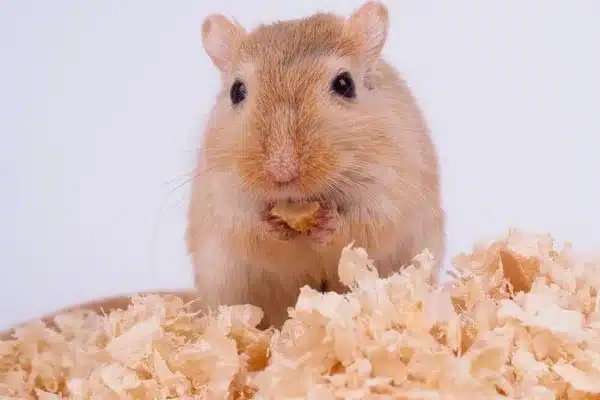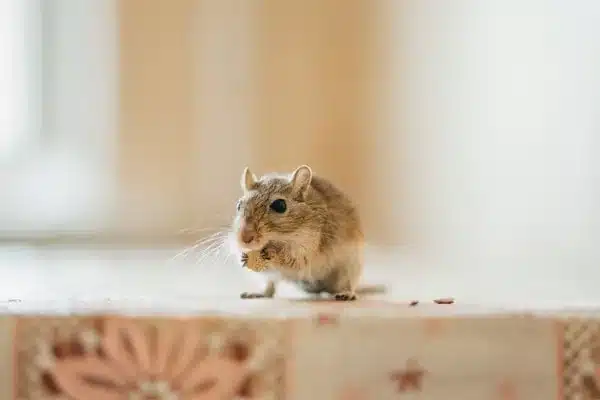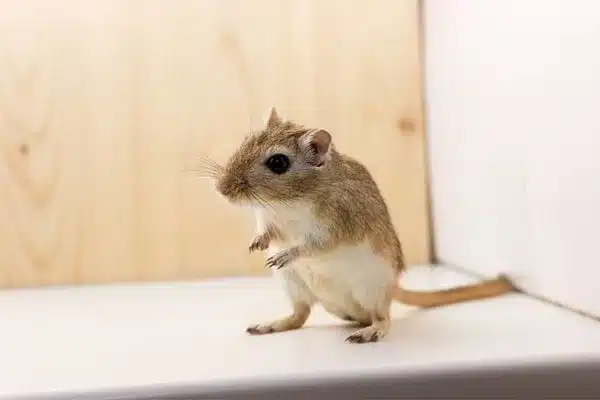Gerbil Care Guide

Gerbils Need Friends
If you have or are thinking about adopting a single gerbil, it’s important to consider adopting another one or adopting two together, instead. Gerbils are extremely social creatures, and they can become depressed and ill when housed alone.
It’s best to adopt two gerbils from the same litter at the same time. You can also adopt three gerbils or more, as long as you have a large enough enclosure for all of them. Try to choose just one “alpha” gerbil and ensure that the others are more submissive in nature. This can help keep the social hierarchy of the group intact.

Gerbil Enclosures
A gerbil habitat, or gerbilarium as it’s also sometimes known, is the foremost factor in keeping your gerbils happy and healthy. A gerbilarium must provide adequate space for your gerbils to run, hide, jump, and dig.
We recommend choosing a 40-gallon breeder tank for two gerbils or a 55-gallon tank for more. These provide sufficient space both vertically and horizontally, and they prevent your gerbils from kicking their bedding out of the enclosure. You may also choose a cage with bars, as long as it has a deep tray that allows for burrowing.
The bare minimum dimensions for a gerbil cage for two gerbils are 28 inches long by 14 inches wide by 20 inches tall. If you’re working in gallons, you need at least 10 gallons per gerbil.
However, we recommend at least 620 square inches of floor space for two gerbils.
Learn more about the ideal gerbil enclosure size here and our picks for the best gerbil cages here.

Gerbil Bedding
Gerbil bedding is another key factor in your pets’ well-being. Gerbils need at least six inches of bedding so that they can comfortably dig complex tunnels and hollow out sleeping burrows.
We recommend using a mix of shredded paper bedding, aspen wood chips, and Timothy hay. This mixture creates a substrate that’s dense yet breathable and holds its shape easily for tunnels and burrows.
An added benefit is that the Timothy hay offers chewing enrichment and an occasional snack if your gerbils so choose. Gerbils will also chew up any cardboard, fiber, or non-toxic wood toy you put in their enclosure and use the shredded pieces as bedding.
Learn more about the best bedding for gerbils here.

Food and Water
Gerbils need 24-hour access to fresh food and water. The best way to do this is with a small bowl of water or a water bottle, as well as scattered food.
In the wild, gerbils eat a mix of grasses, seeds, grains, and insects. Although they’re often mistaken as herbivores, gerbils are actually omnivores. Many gerbils enjoy a food mix that contains dried insects.
Because gerbils are omnivores, protein is a very important factor in gerbil food. Look for a pellet food that has 12% to 16% guaranteed protein content.
Lab blocks or pellets should not be a gerbil’s sole source of nutrition. A seed mix should also be provided to allow your gerbils to express their natural foraging instincts. Additionally, you should try to provide a small quantity of fresh vegetables and fruit on a regular basis.
It’s also important to provide Timothy hay or other types of hay for your hamster to chew on, which helps keep their teeth trim. Timothy hay is not a primary food source for gerbils.
Learn more about what gerbils eat here.

Hides and Tunnels
Gerbils need at least one hideout, tunnel, or nest box to cuddle up in. These can be as simple as a toilet paper roll, a small flower pot, or a coffee mug.
Make sure that they’re safe for your gerbil to chew: no toxic paints or glues, no staples or nails, no treated wood, and preferably made of cardboard or untreated wood.
Gerbils can and will chew up everything you give them, so making a hide out of a small cardboard box is totally acceptable and encouraged.
Your gerbils will eventually create their own tunnels and burrows with the bedding you provide, but giving them a hideout gives them a starting place and helps them feel safe.
It’s important to keep in mind that providing too many different hides can cause your gerbils to declan, as they may decide to sleep apart. This can be dangerous for your gerbils. Whenever adding new hides or other items, go slowly and introduce one thing at a time.

Chews and Toys
Like other rodents, gerbils’ teeth grow continuously throughout their life. That’s why it’s so important to provide chew toys, such as apple wood sticks, cardboard, paper, or untreated wood blocks.
You can also provide Timothy hay as a nesting material, snack, and chewing activity that can help keep your gerbils’ teeth trim.
Make sure that your gerbils have at least one “project” going at all times. This could be a couple of paper towel rolls, a whole shoebox, or a dozen tissues.
Just ensure that your gerbils never want for something to chew up and turn into nesting materials.

Exercise Wheel
Gerbils need a wheel in their cage or tank to help them stay active and mentally stimulated. Almost all gerbils enjoy running on a wheel, so it’s important to provide one.
When choosing a gerbil wheel, look for one that is solid and stable, especially if it’s a standing wheel rather than one that attaches to the bars of the cage.
The gerbil wheel should be made of wood or plastic, rather than metal bars or mesh. Metal bars and mesh wheels are hard on a gerbil’s feet, and they can even cause injury to your gerbils.
It’s also important to make sure the wheel is large enough for your gerbils to run on it without their backs bending. The bigger the wheel, the better. We recommend a 10″ or 12″ wheel for gerbils.
Gerbils tend to urinate while they run, which is totally normal. For this reason, you’ll likely need to take the wheel out of the enclosure and wash it at least every other day.

Playtime
Gerbils shouldn’t spend all of their time inside their cage or tank. It’s also important to let your gerbils explore new areas while helping them feel safe.
Once you’ve bonded with your gerbils and they feel safe being held, you can set up a playpen that you can sit in with your gerbils.
You can purchase a small pet playpen or make one yourself out of cardboard boxes. The idea is to block off an area of space where your gerbils can run around, explore some new items, and interact with you more closely.
Lay out some unique toys and activities like a novel wheel or a big box of sand. Make sure that your gerbils always have somewhere to hide out if they feel nervous.
Don’t ever put your gerbils in a hamster ball! These are dangerous for all small pets and not enjoyable for the animal. Open playtime is much more beneficial and not dangerous.

Sand Bath
Gerbils are clean creatures and don’t need bathing by their owners. They groom themselves and each other very sufficiently. However, if you notice your gerbils looking ruffled or dirty, they might enjoy bathing themselves in a sand bath.
Not every gerbil likes taking sand baths, but it’s a good idea to offer it anyway. Many gerbils simply enjoy digging around in a jar or box full of sand. Choose sand that is dust-free and safe for small animals. Don’t use chinchilla “dust,” since this is too fine for a gerbil’s coat and can even cause respiratory distress.
You don’t need to provide access to the sand bath 24-7, but you can if it suits your particular gerbils. Some gerbils will become territorial over the sand bath, which can lead to declanning. The better option may be to provide the sand bath once per week during playtime or inside their enclosure.
Make sure to sift or change the sand in your gerbils’ sand bath regularly, especially if they decide to use it as a bathroom.

Gerbils Are Crepuscular
Many people believe that gerbils are diurnal, which would mean they’re active during the day and sleep at night, like humans.
However, gerbils are actually crepuscular in captivity, which means that they’re most active at dawn and dusk. Gerbils sleep a total of about 12 hours every day, but they don’t do it in long stretches.
